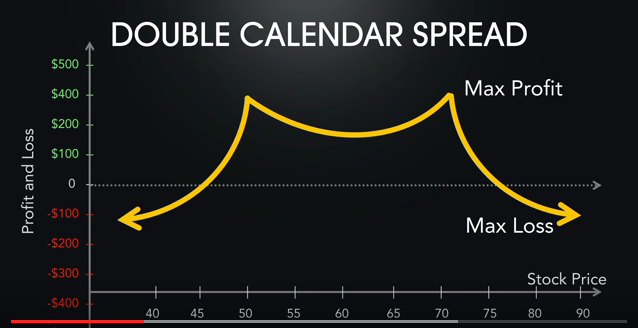Options trading can be an exciting and potentially lucrative investment strategy, but it’s important to understand the risks and rewards involved. One options trading strategy that has gained popularity in recent years is the double calendar spread.
The double calendar spread is a complex options trading strategy that involves buying and selling two calendar spreads. A calendar spread is a type of options position where the trader buys and sells two options contracts with the same strike price, but different expiration dates. In a double calendar spread, the trader buys a call and a put option with a longer-term expiration date and sells a call and a put option with a shorter-term expiration date.
The goal of the double calendar spread is to profit from the difference in time decay between the shorter-term and longer-term options positions. As time passes, the shorter-term options will decay faster than the longer-term options, which can result in a profit for the trader. However, there are risks involved with this strategy, including the potential for loss if the underlying asset price moves in an unexpected direction.
In this article, we’ll explore the double calendar spread in more detail, including how it works, the risks and rewards, and some practical examples of using this strategy in options trading. By the end of this article, you should have a better understanding of the double calendar spread and be able to make an informed decision about whether it’s a strategy that’s right for your options trading goals.
How Do Double Calendar Spread Work?
To understand how this strategy works, let’s consider a concrete example. Suppose that a trader is bullish on a particular stock and believes that the stock will increase in value over the next few months. The trader also believes that the stock is unlikely to experience significant price movements in the short term.

To take advantage of this view, the trader could use a double calendar spread strategy. The trader would begin by buying a call option and a put option with a longer-term expiration date, such as six months from now. This establishes a long position in the options market, allowing the trader to profit if the stock price moves significantly in either direction.
Next, the trader would sell a call option and a put option with a shorter-term expiration date, such as one month from now. This establishes a short position in the options market, allowing the trader to profit from the difference in time decay between the short-term and long-term options positions.
Suppose that the trader sells the one-month call option and put option for a total premium of $200. If the options expire worthless at the end of the one-month period, the trader would keep the entire premium as profit. This would be the profit from the short options position.
If the stock price remains relatively stable over the next month, the short options positions would expire worthless, and the trader would keep the entire premium as profit. Meanwhile, the long options positions would remain in place and could potentially profit if the stock price moves significantly in either direction.
Suppose that, six months from now, the stock price has increased significantly, and the trader decides to exercise the call option. If the call option has a strike price of $50 and the stock price is now $60, the trader could exercise the option and purchase 100 shares of the stock at $50 per share. The trader could then sell the stock at the current market price of $60 per share, realizing a profit of $1,000 (100 shares x $10 gain per share).
If the stock price remains stable or only increases slightly over the next six months, the long options positions could expire worthless, and the trader would lose the premium paid for those options. However, the profit from the short options positions could offset some or all of that loss.
It’s important to note that a double calendar spread is a complex strategy that involves multiple transactions and risks. The potential profit and loss of this strategy will depend on the movement of the underlying asset price, the volatility of the market, and other factors. As with any trading strategy, it’s important for traders to understand the risks involved and to carefully consider whether a double calendar spread is a suitable strategy for their individual investment goals and risk tolerance.
What is The Risk of Double Calendar Spreads?
Like all trading strategies, double calendar spreads carry certain risks that traders should be aware of before implementing the strategy. The following are some of the key risks associated with this strategy:
- Market risk: The biggest risk of a double calendar spread is market risk. If the stock price moves in an unexpected way, it can result in a loss for the trader. While a double calendar spread is designed to profit from stable prices in the short term and potential volatility in the long term, unexpected market movements can result in losses.
- Time decay risk: The success of a double calendar spread depends on the difference in time decay between the short-term and long-term options positions. If the short-term options positions decay too quickly, the trader may not be able to collect enough premium to offset the cost of the long-term options positions.
- Commission and transaction costs: A double calendar spread involves multiple transactions, which can result in high commission and transaction costs. These costs can eat into the profits of the strategy, especially for small trades.
- Liquidity risk: Depending on the options market, it may be difficult to find buyers and sellers for the specific options contracts required for a double calendar spread. This can result in difficulty executing the strategy or receiving a fair price for the options contracts.
Overall, a double calendar spread is a complex trading strategy that carries a variety of risks. Traders should carefully consider these risks and ensure that the potential benefits of the strategy outweigh the potential costs and risks involved.
Conclusion
Double calendar spreads are a complex trading strategy that involves multiple options positions and can provide traders with a way to potentially profit from stable prices in the short term and volatility in the long term. However, like all trading strategies, they come with certain risks and potential downsides that traders should carefully consider before implementing the strategy.
One of the main benefits of a double calendar spread is that it allows traders to profit from both stable prices and volatility, making it a versatile strategy that can be used in a variety of market conditions. By combining long-term and short-term options positions, traders can potentially profit from market movements in both the short and long term.
However, there are also risks involved with this strategy, including market risk, time decay risk, commission and transaction costs, and liquidity risk. Market risk is a major risk associated with double calendar spreads, as unexpected market movements can result in losses for the trader. Time decay risk is also a concern, as the success of the strategy depends on the difference in time decay between the short-term and long-term options positions. Commission and transaction costs can also eat into the profits of the strategy, especially for small trades. Finally, liquidity risk can be an issue if the options market is not sufficiently active, making it difficult to find buyers and sellers for the specific options contracts required for the strategy.
In conclusion, a double calendar spread can be a useful tool for traders looking to profit from market movements while minimizing their risk exposure. However, it is important to approach this strategy with caution and carefully consider the potential risks and rewards before implementing it in your trading activities. Traders should be aware of the market risk, time decay risk, commission and transaction costs, and liquidity risk associated with this strategy, and ensure that the potential benefits of the strategy outweigh the potential costs and risks involved. By carefully assessing these factors, traders can make informed decisions about whether a double calendar spread is the right strategy for their trading goals and risk tolerance.
n.b: this is not financial advice
